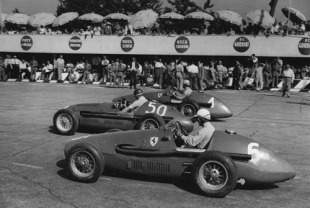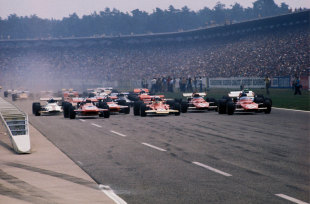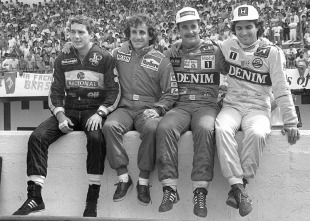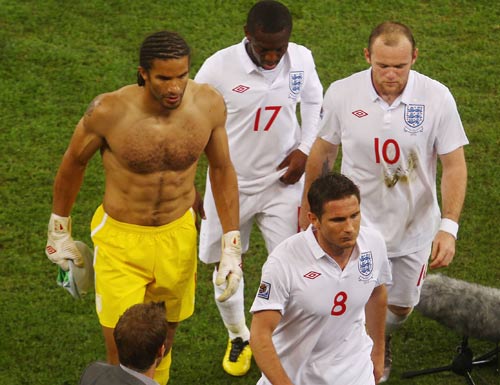With a record six champions on the grid in 2012, we look back at some of the most talented fields in the sport's history

Juan Manuel Fangio's Maserati is sandwiched by the Ferraris of Alberto Ascari and Nino Farina at the 1953 Italian Grand Prix © Getty Images
Enlarge
1953
Although the cars were still being run to Formula 2 regulations in 1953, the drivers filling the cockpits were top class. Alberto Ascari was in his prime and took his second consecutive title by holding off Juan Manuel Fangio, who had made a full recovery from a broken neck in 1952, and 1950 champion Nino Farina. The season also saw the emergence of a talented group of drivers from Great Britain as Mike Hawthorn took his first Formula One victory and Stirling Moss and Peter Collins showed huge potential in less competitive cars.Champions: 3
Future champions: 1
1960
The turn of the decade saw a shift from front-engined to mid-engined F1 cars, and with it the merging of two generations of great F1 drivers. Jack Brabham took his second title by nine points from Bruce McLaren, but would have had a tougher fight from Stirling Moss had it not been for a serious mid-season accident. Phil Hill took the only win for Ferrari, which was still campaigning its front-engined 246 Dino, but went on to win the title the following year when his team finally shifted its V6 motor behind the driver. Jim Clark made his debut at the Dutch Grand Prix and scored eight points by the end of the season, while John Surtees started to dabble with four wheels rather than two and made his championship debut at the Monaco Grand Prix. Graham Hill was yet another future champion on the grid but struggled in the unreliable BRM.Champions: 1
Future champions: 4
1965
By the mid-1960s Lotus was the team to beat and in 1965 Jim Clark took his second title driving one of Colin Chapman's cars. Clark was revered by his rivals, although many of them were outstanding drivers in their own right. Graham Hill came closest to matching Clark in the drivers' standings, but was still 14 points short, while Jackie Stewart made an explosive debut to ensure the top three drivers in the championship were all British. Another future champion making his debut was Denny Hulme while Jochen Rindt took part in his first full season. Other notable names on the grid were John Surtees, Bruce McLaren, Jack Brabham and Pedro Rodriguez.Champions: 4
Future champions: 3

1970 featured a grid with five former champions © Sutton Images
Enlarge
1970
The '70s saw a new breed of F1 drivers, introducing sideburns, shaggy hair and sexy 'hangers-on' to the sport, but in 1970 there was still several of the members of the old guard soldiering on. Jochen Rindt secured the title his talent deserved, but tragically only after his death at the tenth round at Monza. It had been an annus horribilis for the sport with the loss of Piers Courage and Bruce McLaren earlier in the season, but F1 was still considered the pinnacle of motorsport and several great talents were willing to risk everything, week-in-week-out. There were five champions on the grid: Jackie Stewart, Denny Hulme, Jack Brabham, Graham Hill and John Surtees while new talents were emerging in the likes of Emerson Fittipaldi, Mario Andretti and Francois Cevert.Champions: 5
Future champions: 3
1973
By 1973 F1's two biggest names were Jackie Stewart and Emerson Fiitipaldi, but the former - fully aware of the dangers of the sport - decided to retire at the top of his game at the end of the year. Stewart took his third world title against tough competition, with Ronnie Peterson partnering Fittipaldi at Lotus and Denny Hulme and Peter Revson at McLaren. Jacky Ickx was still at Ferrari while James Hunt, Niki Lauda and Jody Scheckter were all making names for themselves at smaller teams. But it was another season marred by tragedy as Francois Cevert, who Stewart had tipped for title glory in the coming years, died at the final round and Roger Williamson, a hugely-talented newcomer from Leicester, lost his life earlier in the season.Champions: 4
Future champions: 3
1981
Nelson Piquet won his first championship in 1981 after a fantastic title battle with Carlos Reutemann, albeit with a slightly anti-climatic final instalment at Las Vegas. By that time, legends of the 1970s such as Emerson Fittipaldi, James Hunt and Jody Scheckter had retired, although Mario Andretti was still feeding his insatiable appetite for motor racing at the top level. Gilles Villeneuve was on hand to provide the entertainment in his wayward Ferrari 126C and remarkably took two sensational victories in Monaco and Spain. But there was also a new generation making their names, with Alain Prost and Nigel Mansell hitting the big time while Keke Rosberg was just one year away from his title-winning season with Williams in 1982.Champions: 2
Future champions: 5

The heroes of the 1986 season pose for a photo on Estoril's pit wall © Getty Images
Enlarge
1986
Although the pool of driving talent did not change massively between 1981 and 1986, there was a titanic battle between four of the sport's greatest fighters for the title. Alain Prost, Nigel Mansell, Nelson Piquet and Ayrton Senna had been fighting hard all season and by the final round Prost, Mansell and Piquet all had a shot at the title. In a dramatic finale at Adelaide, a tyre blow-out cost Mansell his shot at the title and team-mate Piquet suffered similar problems. Prost took the title, but all three of his rivals would taste title success over the following few years.Champions: 4
Future champions: 2
1991
By 1991 Ayrton Senna was in his prime and duly took a third world title with McLaren. He faced incredibly stiff opposition from Nigel Mansell at Williams, but reliability kept the championship out of the Briton's reach for another year. Alain Prost, meanwhile, was struggling at Ferrari and took a sabbatical at the end of the year before one final title with Williams in 1993. It was also a year for impressive debuts as Michael Schumacher arrived on the scene in a Jordan at Spa Francorchamps and qualified seventh and Mika Hakkinen snatched a couple of points his Lotus didn't really deserve at the San Marino Grand Prix.Champions: 2
Future champions: 3
2001
Although Michael Schumacher dominated the season, 2001 marked the emergence of several talents that would go on to fight and beat him over the following decade. The careers of his old rivals such as Jacques Villeneuve and Damon Hill were in decline or over, while Mika Hakkinen's back-to-back titles in 1998 and 1999 meant he was happy to call time on his career at the end of the year. However, Fernando Alonso/A>, Kimi Raikkonen and Juan Pablo Montoya all arrived on the scene - the latter in a car capable of taking the fight to Schumacher straight away. Jenson Button was also continuing to learn the ropes in his second year, albeit in an uncompetitive Renault.Champions: 3
Future champions: 3
2011
Michael Schumacher's return in 2010 created headlines at the start of the year but it was his young compatriot Sebastian Vettel who was filling the column inches by the end of the season. For 2011 five champions lined up on the grid: Schumacher, Vettel, Fernando Alonso, Lewis Hamilton and Jenson Button as the sport entered a new golden era in terms of driver talent. 2012 sees Kimi Raikkonen added to that list to create a record-breaking six champions on the grid. Enjoy it while it lasts.Champions: 5
Future champions: ?
Laurence Edmondson is an assistant editor on ESPNF1
© ESPN Sports Media Ltd.
Laurence Edmondson

 Laurence Edmondson is deputy editor of ESPNF1 Laurence Edmondson grew up on a Sunday afternoon diet of Ayrton Senna and Nigel Mansell and first stepped in the paddock as a Bridgestone competition finalist in 2005. He worked for ITV-F1 after graduating from university and has been ESPNF1's deputy editor since 2010
Laurence Edmondson is deputy editor of ESPNF1 Laurence Edmondson grew up on a Sunday afternoon diet of Ayrton Senna and Nigel Mansell and first stepped in the paddock as a Bridgestone competition finalist in 2005. He worked for ITV-F1 after graduating from university and has been ESPNF1's deputy editor since 2010

